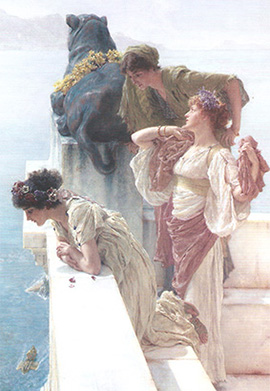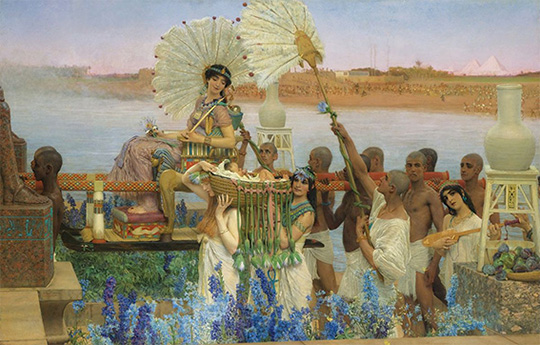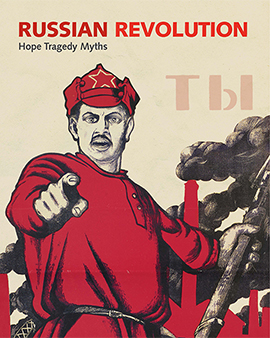Two Great Exhibitions: Sir Laurence Alma-Tadema’s vision of the ancient world & the Russian Revolution
Thursday, 3 August 2017 The Leighton House Museum in the London suburb of Kensington (very close to the new Design Museum) has a wonderful exhibit on the art of Sir Laurence Alma-Tadema running until 29 October. It’s ‘the largest exhibition in London since 1913’ on his art and makes an interesting foray through his work, his life, his family, his connections, his influence. The exhibition is subtitled ‘At Home in Antiquity’ since many of our ideas of life in the Roman and Egyptian eras relate to the images Alma-Tadema conjured up.
The Leighton House Museum in the London suburb of Kensington (very close to the new Design Museum) has a wonderful exhibit on the art of Sir Laurence Alma-Tadema running until 29 October. It’s ‘the largest exhibition in London since 1913’ on his art and makes an interesting foray through his work, his life, his family, his connections, his influence. The exhibition is subtitled ‘At Home in Antiquity’ since many of our ideas of life in the Roman and Egyptian eras relate to the images Alma-Tadema conjured up.
◄ A Coign of Vantage, 1895
Towards the end there’s a room on his theatrical and cinematic influences, I loved how some movie scenes were so clearly related to particular paintings – Yul Bryner in The Ten Commandments and scenes in Ridley Scott’s much more recent Gladiator.
I’ve always loved Alma-Tadema’s work and its extraordinarily detailed imagery really resonates today although it’s interesting how he completely fell out of favour soon after his death. The final room of the exhibition has some of his late works, which include some of the most detailed and evocative of his style, a style which certainly wasn’t at the cutting edge when impressionism, Picasso and everything else followed Alma-Tadema’s Victorian era.
 ▲ The story of the financial decline, fall and then recent rise of The Finding of Moses, which is on exhibit, tells the story. In 1904 the painting was sold to Sir John Aird for £5250 plus expenses, in 1935 it only fetched £861 and by 1942 it was down to £273 and in 1950 it was supposedly sold only for its frame, the painting was considered worthless. In 1960 it couldn’t find a buyer, but in 1967 it was sold in the USA for US$8500, then to Alan Funt of Candid Camera fame for US$25,000. Funt was a believer in Alma-Tadema and sold it in 1973 for US$72,000, two more sales and in 1995 it went for US$2.75 million and then in 2010 for US$36 million. Clearly he’s back in favour!
▲ The story of the financial decline, fall and then recent rise of The Finding of Moses, which is on exhibit, tells the story. In 1904 the painting was sold to Sir John Aird for £5250 plus expenses, in 1935 it only fetched £861 and by 1942 it was down to £273 and in 1950 it was supposedly sold only for its frame, the painting was considered worthless. In 1960 it couldn’t find a buyer, but in 1967 it was sold in the USA for US$8500, then to Alan Funt of Candid Camera fame for US$25,000. Funt was a believer in Alma-Tadema and sold it in 1973 for US$72,000, two more sales and in 1995 it went for US$2.75 million and then in 2010 for US$36 million. Clearly he’s back in favour!
 ◄ Also in London the Russian Revolution is running at the British Library until 29 August. This exhibit is subtitled Hope, Tragedy, Myths and follows the dramatic ups and downs of the collapse of feudal Russia and the Tsar, the dramatic events of the civil war, the rise of the Bolsheviks, the arrival of Lenin and the creation of the Soviet Union. Of course Russia today is still a country in turmoil, the entanglement with Trump and his entourage is only part of the picture. At a dinner last week someone pointed out that the Russian economy is no larger than that of Australia. I was so amazed I went straight to Professor Google when I got home: Russia’s GDP is US$1.283 trillion while Australia’s is US$1.205 trillion. So in fact Russia has a slightly larger Gross Domestic Product, but Russia also has a population six times as large as Australia’s, 144 million versus 24 million.
◄ Also in London the Russian Revolution is running at the British Library until 29 August. This exhibit is subtitled Hope, Tragedy, Myths and follows the dramatic ups and downs of the collapse of feudal Russia and the Tsar, the dramatic events of the civil war, the rise of the Bolsheviks, the arrival of Lenin and the creation of the Soviet Union. Of course Russia today is still a country in turmoil, the entanglement with Trump and his entourage is only part of the picture. At a dinner last week someone pointed out that the Russian economy is no larger than that of Australia. I was so amazed I went straight to Professor Google when I got home: Russia’s GDP is US$1.283 trillion while Australia’s is US$1.205 trillion. So in fact Russia has a slightly larger Gross Domestic Product, but Russia also has a population six times as large as Australia’s, 144 million versus 24 million.






